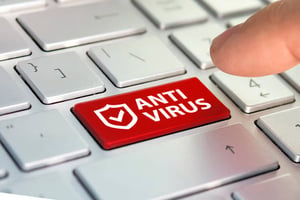Top 15 Techniques to Protect your Workstation from Ransomware and Malware.

Workstations are computers that are specifically configured to meet the most demanding technical computing requirements. Workstations are in different forms they may be a mobile laptop, a desktop tower or a rackmount system. To be considered as a workstation, systems must include key capabilities related to performance, reliability integrity, free from malware and ransomware infections.
Protecting your workstation from ransomware and malware requires a flexible approach that includes both technical measures and user education. Simply because if a workstation is compromised or attacked all of its data could be lost. Such as information may be irreplaceable, like email documents, presentation, videos, business quotations and documents.
Here we have 15 techniques to help safeguard your workstation:
1. Use Antivirus and Anti-Malware Software: It is very important to protect your workstation from malicious files by installing an antivirus and anti-malware software. It is programmed by a software engineer. What it simply does is that it searches any sign of malware by tirelessly scanning any downloaded files or devices on your workstation. If it finds anything suspicious it eradicates the treats by removing such malicious program from infected files.
These are the regular routines to follow:
1. Install reputable antivirus and anti-malware software and keep it up to date.
2. Always Schedule regular scans to detect and remove malicious software.
There are many anti-viruses and anti-malwares software that you can install, or you can also opt in for a paid subscription or free service depending on your capability some of the most recommended antivirus software include AVG, Avira, Kaspersky security cloud etc.
2. Enable Automatic Software Updates: In the case of a workstation that has been compromised or infected, a backup makes it possible to reset a workstation with little or no interruption to regular operations. When you regularly update the operating system of your workstation, software applications, and security software it provides new and improved functionality while addressing existing issues that needed to be handled. Also, software developers can often continue to improve their products to keep you safe from new malware and ransomware attacks. Put an automatic update whenever possible to ensure immediate spotting of vulnerabilities and infections.
3. Secure Email Practices: Cyber attackers create a very tricky and scary emails to encourage clicking on a link. As soon as answer are given to such request, they have access into your workstation by downloading malware and ransomware viruses that infiltrates your network system. Be cautious with email attachments and links.
Avoid opening attachments or clicking on links from unknown or suspicious sources. Make use of email filtering solutions or a sender’s identity to identify and block malicious emails. You can call, forward the email to your IT department so they can run checks.
4. Employee Training and Awareness: Human error is inevitable, and accounts for all cyber-attacks that happens in our workstations. These errors are because of lack of appropriate awareness of cybersecurity knowledge of employees. This can easily be handled by always attending IT trainings in your workplace. Provide cybersecurity training to employees to recognize and avoid phishing emails, malicious links, and social engineering tactics. Secondly, foster a security-aware culture within the organization because cybersecurity awareness is evolving each day.
5. Network Segmentation: Network segmentation is a vital strategy to protect your workstation by dividing a network into distinct segment with a specific security control. Segments can be based on your user role locations and services. Segmentation decreases the attack surface hindering unauthorized access to sensitive information of workstations. Segment your network to limit the spread of malware in case of an infection. Also restrict access rights to ensure that users have the minimum necessary permissions. This helps enhance the flow of network performance.
6. Backup Critical Data in your workstation: Regularly backup important data and ensure that backups are stored securely. Implement a backup strategy that includes both onsite and off-site storage options in your company’s cloud account this protects you not whenever your workstations or any devices gets lost or damaged. This is simply because you will be able to recover or get back when by downloading data that was back up and installing them on a new device. Saving backups on the cloud is easiest method of retrieving data. This online technology requires a cyber security expert.
7. Implement Application Whitelisting: Use application whitelisting to allow only approved applications to run on workstations. This helps prevent unauthorized or malicious software from executing. It is a cybersecurity strategy that gives preference to only approved apps, IP addresses or email addresses. Whitelisting prevents malware code, ransomware and block cyber attackers from our workstations.
8. Disable Macro in Office Documents: Disable macros in Microsoft Office documents, as they can be used to deliver malware. A macro is a programmed language is rooted inside a software application. Also enable macro controls and educate users about the risks associated with enabling macros. Contact your IT Team or software engineer.
9.Patch Management: Keep software and applications updated with the latest security patches. Implement a robust patch management system to address vulnerabilities promptly on your software and workstations that are susceptible to cyberattacks. This helps your business organization reduce risks from hackers. Effective patch management helps to ensure best operating performance and boost productivity.
10.Use a Firewall: All workstation devices coworkers use is likely to be connected to the same online network provided by the company. This internet connection between devices allows hackers to have their way to the network. Enabling and configuring firewalls on both workstations and network devices to control incoming and outgoing traffic. This firewall can prevent attacks from happening by building an online wall between internal connections and external traffic that comes in from the internet. Building up a firewall stops any malicious traffic from entering your workstation network. Installing a firewall is a highly complex process, contacting your software engineer or IT team to help install firewall on your workstation. Regularly review and update firewall rules.
11.Endpoint Detection and Response (EDR): EDR is an endpoint security solution that continuously monitors end- user devices to detect and respond to cyber threats. Deploying EDR solutions to detect and respond to advanced threats in real-time. EDR tools provide enhanced visibility into endpoint activities and help stop the impact of potential ransomware and malware infections.
12. Browser Security: Internet has several vulnerabilities that malicious attackers can exploit. Common weaknesses like unlocked pop-ups, malicious redirect insecure plugins. Keep web browsers and plugins updated to address security vulnerabilities. Also use a browser extensions or plugins that block malicious scripts and ads.
13.Restrict User Privileges: There should be an authorization that should be given to users to enable them access specific resources on the workstation. Follow the principle of least privilege, granting users the minimum permissions required to perform their tasks. This maintains a greater stability on your workstation, limits malware and ransomware propagation. Kindly, review regularly and update user privileges based on job roles and responsibilities. Depending on your organization you can create an administration privilege on your workstation.
14.Implement Behavioral Analysis: Behavioral analysis uses cybersecurity machine learning, artificial powered intelligence, security tools to identify abnormal patterns of activity indicative of malware and ransomware in workstations. Behavioral analysis can help detect threats that traditional signature-based methods may miss. What it simply does is that it raises a red flag of suspicion from cyber attackers on your workstation.
15.Security Audits and Penetration Testing: Conducting regular security audits and penetration testing to identify vulnerabilities and weaknesses by your business or organization security audit is very necessary. Security audits are trained professionals they help detect issues that could result in a costly compliance violation. Regularize testing your organization's security posture to ensure it can withstand potential cyber threats.
Conclusion, by combining these techniques and maintaining a proactive stance on cybersecurity, you can significantly reduce the risk of ransomware and malware infections on your workstations. Regularly update your security measures to adapt to the evolving threat landscape and you are at a benchmark of performance.




